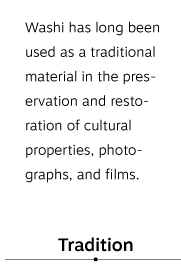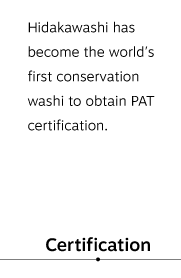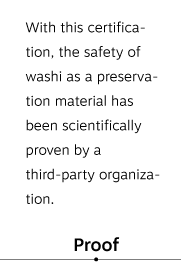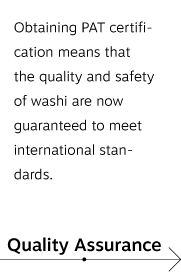
Hidakawashi’s conservation washi has become the first Japanese paper in the world to pass the international safety standard for photographic preservation, the PAT (Photographic Activity Test).
Washi has long been used in the preservation and restoration of cultural properties, photographs, and films, but this is the first time its safety has been scientifically recognized.
This page introduces the significance and details of our PAT certification.
The PAT (Photographic Activity Test) is an international safety evaluation that scientifically determines whether storage materials have any adverse effects on valuable materials such as photographs and films during long-term preservation.
This test is widely recognized as a global standard for assessing whether papers, envelopes, boxes, and other materials used in conservation and restoration may cause chemical changes to photographs and films.
Storage materials that pass the PAT are trusted worldwide as they are objectively and scientifically proven to be safe for photographic and film preservation.
Photographs and films can sometimes deteriorate, discolor, or suffer chemical damage when stored in contact with paper, envelopes, or other materials for long periods of time.
While traditional washi has been highly valued in conservation and restoration fields, its actual safety has often depended on “intuition” or “experience” rather than objective evidence.
This is why scientific verification of safety is required.
PAT certification is a test that objectively proves storage materials are “safe to use,” evaluating their chemical effects on archival materials by international standards.
By achieving PAT certification, washi now combines tradition and proven track record with scientific reliability—making it a trustworthy choice for preserving photographs and films.






Photographs and films can sometimes deteriorate, discolor, or suffer chemical damage when stored in contact with paper, envelopes, or other storage materials for extended periods.
Although traditional washi has long been highly regarded in the field of conservation and restoration, its true safety often relied on intuition or experience rather than objective proof. That’s why scientific verification of safety is essential.
The PAT certification is a test that objectively demonstrates “safe use,” evaluating the chemical impact of storage materials on archival items based on international standards.
With washi now passing the PAT certification, scientific reliability has been added to its tradition and proven track record—allowing you to trust it even more for the preservation of photographs and films.
PAT Certification Test 1
Materials Used
● Image interaction detector:
A “colloidal silver sheet” created by dispersing undeveloped silver particles in gelatin and coating them onto a polyester film.
→ Used to examine the effects of storage materials on photographic images.
●Contamination (stain) detector:
Black-and-white baryta photographic paper that has been fixed, washed, and dried without development.
→ Used to detect the presence of contamination.
●Test sample:
The storage material being evaluated (such as Hidakawashi).
●Reference filter paper:
An inert material used as a control (for pass/fail comparison).
PAT Certification Test 2
Test Method
All materials are cut to the same size and stacked in the following combinations:
A: Test sample + Image interaction detector
B: Reference filter paper + Image interaction detector
C: Test sample + Contamination detector
D: Reference filter paper + Contamination detector

Each of these stacks is placed under high temperature and humidity conditions—70°C (±1°C) and 86% relative humidity (±3%)—for 15 days to artificially accelerate the effects that packaging materials may have on photographic samples.
Additionally, stacks using reference filter paper instead of the test sample are prepared as controls (for pass/fail comparison).
After the forced deterioration process, the change in density is measured at four points on each detector, totaling eight points (4 locations × 2 sheets).
The image interaction detector is measured for transmission density, while the contamination detector is measured for reflection density, using a densitometer.
PAT Certification Test 3
Measurement
After the accelerated aging test, changes in density are measured at four locations on each detector, totaling eight points (4 locations × 2 sheets).
Image interaction detector: Transmission density is measured.
Contamination detector: Reflection density is measured.
Based on these results, the impact of the test sample on photographs and photographic paper is evaluated.
PAT Certification Test 4
Calculation and Criteria
4-1. Image interaction test
Calculate the average change in transmission density at eight locations measured with the image interaction detector for the test sample (A) (①).
Similarly, calculate the average for the reference filter paper (B) (②).
The test sample passes if the change on the test sample side is within ±20% of the reference filter paper.
Image impact (%) = (①−②) / ② × 100
4-2. Contamination test
Calculate the average change in reflection density at eight locations measured with the contamination detector for the test sample (C) (④).
Similarly, calculate the average for the reference filter paper (D) (⑤).
The test sample passes if the change (④) is equal to or less than the reference (⑤) plus 0.08.
4-3. Visual inspection for stains
Check the image interaction detector for stains (such as spots or discoloration) using a light table or uniform light source.
Inspect visually from about an arm’s length (approximately 50 cm) away, and ensure that no obvious stains or patterns are visible—this is the passing criterion.
Examples of stains include uneven light and dark areas, random spots, fiber discoloration, pinholes in gelatin, or glue lines from photo albums.
The final judgment is made by the examiner through visual inspection.